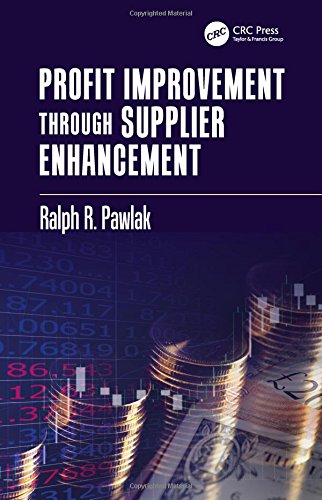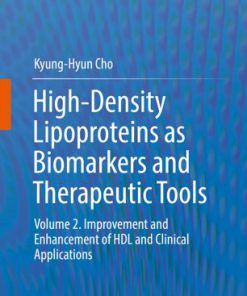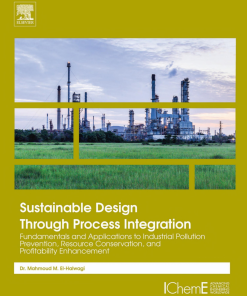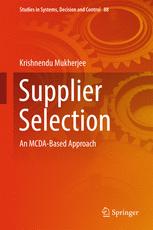Profit improvement through supplier enhancement 1st Edition by Ralph Pawlak ISBN 135178854X 9781351788540
$50.00 Original price was: $50.00.$25.00Current price is: $25.00.
Profit improvement through supplier enhancement 1st Edition by Ralph R. Pawlak- Ebook PDF Instant Download/Delivery: 135178854X, 978- 1351788540
Full download Profit improvement through supplier enhancement 1st Edition after payment

Product details:
ISBN 10: 135178854X
ISBN 13: 978-1351788540
Author: Ralph R. Pawlak
This book deals with the improvement of suppliers in order to increase a company’s top and bottom-line. The enhancement of suppliers can be accomplished in a series of steps when conditions warrant intervention. They can also be generated through direct quality mentoring when the supplier does not have the basic skills or abilities to adequately address impending problems. Also included are guideline activities which will aid in achieving and attaining improved profitability and competitiveness in the world market. Packed with examples, problems, and forms to allow easy establishment of systems, makes the information presented more easily understood, interesting, and useful.
Profit improvement through supplier enhancement 1st Table of contents:
Chapter 1: Introduction
- Features: This section introduces the book’s key features, setting the framework for understanding the challenges and solutions in supplier relationships.
- Means of Supplier Improvement: Discusses strategies and techniques for improving supplier performance and fostering better relationships.
- Flow Path of the Book: Outlines how the chapters are structured to guide readers through the history of supplier problems, need for improvements, actions, and solutions.
Chapter 2: Problem History
- Supplier Errors: Reviews common supplier errors that lead to issues in the supply chain, affecting product quality and delivery.
- Three Types of Supplier Problems: Discusses three distinct categories of problems suppliers may face:
- Inconvenience: Minor disruptions that impact operations but are typically manageable.
- Assessed Severity: More critical problems that need to be addressed quickly due to their potential for larger-scale disruption.
- Criminal Activity: Serious issues involving fraud, theft, or other illegal actions that harm the supply chain.
- Summary: A recap of the key supplier issues discussed, emphasizing the importance of recognizing and addressing supplier problems.
Chapter 3: Need for Enhancement
- Best and Worst Practices: Identifies the best and worst practices in supplier management, providing a framework for recognizing which behaviors need to change.
- Best Practices: Describes actions that ensure smooth supplier relationships, such as clear communication, regular audits, and proactive problem solving.
- Worst Practices: Highlights practices that exacerbate supplier issues, such as neglecting regular inspections or failing to maintain clear agreements.
- Circumstances Found: Examines the different environments and contexts in which best or worst practices may arise.
- Most Important Action: Discusses the most impactful action to take to improve supplier performance.
- Established Practices: Reviews practices that have been effective in improving supplier relationships.
- Conditions Eliminated or Controlled: Discusses how certain negative conditions can be eliminated through proper practices.
- Problems Encountered: Reflects on the challenges faced while attempting to implement improvements.
- Summary: A summary of the key takeaways from this chapter, including which practices should be prioritized.
Chapter 4: Supplier Credentials
- Types of Suppliers: Describes various types of suppliers (e.g., raw materials suppliers, component manufacturers) and their roles in the supply chain.
- Supplier Traits: Discusses the characteristics of a good supplier, such as reliability, transparency, and quality assurance practices.
- Narrative on Suppliers: Provides case studies or examples that highlight the relationship between a company and its suppliers.
- Suppliers Needing Improvement: Identifies common issues with underperforming suppliers and outlines necessary improvements.
- Red Dye Problem: Describes a specific issue with a supplier related to defective red dye.
- Disappearing Materials: Details a case where materials from a supplier were inconsistent or unavailable.
- Supplier Negligence: Examines instances of suppliers failing to meet expectations or contractual obligations.
- Summary: Summarizes the key points about supplier selection, credentials, and areas for improvement.
Chapter 5: Supplier Elements
- Focus of Supplier Traits: Examines the traits that are most important to focus on when evaluating and improving suppliers.
- Process Control Plans: Discusses the importance of having detailed process control plans to ensure consistency and quality from suppliers.
- Summary: Recaps the main points on managing supplier elements and implementing control plans.
Chapter 6: Course of Action
- Incoming Inspection Elimination: Proposes eliminating or reducing the need for incoming inspections by improving supplier quality upfront.
- Employee Responsibilities: Outlines the responsibilities of employees in managing supplier relations and resolving issues.
- Immediate Contact: Stresses the importance of swift communication with suppliers when problems arise.
- Conduct a Series of Meetings: Encourages ongoing discussions with suppliers to resolve issues collaboratively.
- Supplier Visits: Recommends regular visits to supplier facilities to ensure quality control and maintain strong relationships.
- Supplier Symposiums: Suggests organizing forums or events where suppliers can share best practices and learn from each other.
- Problems that Suppliers Cause: Identifies common issues that suppliers may cause in the supply chain.
- Mentor Review: Discusses the use of mentor programs to help suppliers improve their processes.
- Problem Resolution: Offers guidance on how to effectively resolve problems with suppliers.
- Summary: Summarizes the action plan for improving supplier relationships and addressing issues.
Chapter 7: Record Keeping
- Mandate Origination: Describes the importance of having clear records of supplier agreements and mandates.
- Statement of the Problem: Highlights how to document problems encountered with suppliers.
- Description of Failure Modes: Discusses how to document failure modes related to supplier issues.
- Product Containment: Outlines how to manage and contain defective products from suppliers.
- Date Code Interpretation and Use: Explains how date codes are used in tracking supplier products.
- Process Flow Plan: Describes the importance of mapping out process flows to ensure quality.
- Summary: Recaps the need for thorough documentation in managing supplier issues.
Chapter 8: Supplier Readiness
- Other Supplier Features: Identifies additional supplier traits that can affect supply chain performance, such as flexibility and scalability.
- Supply Chain Concerns: Explores issues within the broader supply chain that may affect supplier readiness.
- Installation Concerns: Discusses issues related to the installation of products supplied.
- Manpower Concerns: Addresses the importance of having enough skilled labor at the supplier’s facility.
- Maintenance Concerns: Highlights the need for suppliers to maintain their equipment and systems.
- Major Issues and Concerns: Identifies the most significant concerns when evaluating a supplier’s readiness.
- Case 1: Wooden Rulers: Discusses a specific case where a supplier struggled with product consistency.
- Case 2: Whiteout: Describes a situation involving a supplier’s failure to meet quality expectations.
- Case 3: Unauthorized Sign: Provides an example of a supplier violating agreed-upon terms or using unapproved materials.
- Summary: Summarizes the key takeaways regarding supplier readiness and common concerns.
Chapter 9: Opportunities for Improvement
- Improvement Opportunities: Identifies areas where improvements can be made in supplier management.
- Prevention: Discusses preventive measures to avoid supplier problems.
- Container Use and Practice: Explores best practices for packaging and container management with suppliers.
- Sorting Concerns: Addresses issues related to sorting and inventory management with suppliers.
- People Concerns: Looks at human factors that influence supplier performance.
- Method Used: Outlines the methods used to address supplier issues and implement improvements.
- Other Concerns: Discusses additional factors that may impact supplier performance.
- Summary: Recaps the various opportunities for improving supplier relationships and practices.
Chapter 10: Problem Resolution Aids
- Three Items of Compliance: Identifies three critical compliance issues that need to be addressed in problem resolution.
- Problem History: Revisits common supplier problems and their histories.
- Leaking Front Seal Problem Solution: Provides a case study on resolving a specific supplier issue involving a front seal leak.
- Front Cover Oil Seal Leak: Audit: Outlines the audit process for resolving an oil seal leak issue.
- O-Ring Problem: Discusses the O-ring failure and its resolution.
- Summary: Summarizes the problem resolution techniques and case studies discussed.
Chapter 11: System Evaluation
- Deliverables: Defines what should be delivered in the evaluation of the supplier system.
- Audit Charts: Discusses the importance of audit charts in monitoring supplier performance.
- Summary: Recaps the need for system evaluation and tracking supplier performance.
Chapter 12: Other Requirements
- Corrective Action Criteria: Identifies the criteria for corrective actions when supplier issues are identified.
- Required Compliance: Lists compliance requirements that suppliers must meet.
- Documentation of the Quality System: Discusses the importance of documenting quality processes.
- Implementation of the Quality Plan: Describes how to implement quality plans with suppliers.
- Availability of Records and Information: Outlines how records and information should be available for auditing and decision-making.
- Management Participation: Emphasizes the role of management in resolving supplier issues.
- Management Actions: Outlines management’s role in corrective action and supplier relations.
- New Contract Requirements: Discusses contract changes necessary to improve supplier relationships.
- Workstation Operations: Reviews operational requirements at supplier locations.
- Quality Process Pointers: Provides guidelines for improving quality processes with suppliers.
- Manufacturing Metrics: Discusses the need for manufacturing metrics to measure supplier performance.
- Compliance and Performance Readiness: Reviews how to assess supplier readiness for compliance and performance.
- Operational Issues: Identifies operational concerns that can affect supplier management.
- Raw and Finished Material Metrics: Describes the importance of tracking raw and finished materials.
- Plant Visits and Tours: Recommends regular visits to supplier plants to assess performance.
- Summary: Summarizes the additional requirements necessary for managing supplier relationships and compliance.
Chapter 13: Tools for Improvement
- Answering the Right Questions: Discusses how to identify the right questions to ask in supplier evaluations.
- A Means for Achieving Production Schedules: Looks at tools to help achieve production schedules in collaboration with suppliers.
- Document Provided for Flywheels: Provides examples of documentation for managing flywheel production.
- Causes of Failure: Identifies common causes of failure in supplier relationships and how to address them.
- Flywheel Final Resolution: Discusses how to resolve supplier issues related to flywheels.
- Summary: Summarizes the tools and methods for improving supplier performance.
Chapter 14: Useful Audit Criteria
- Example Audit Considerations: Provides examples of audit criteria to evaluate suppliers.
- Summary: Summarizes the audit process for assessing suppliers.
Chapter 15: Summary
A comprehensive review of the entire book, summarizing key points and takeaways on supplier management, improvements, and best practices.
People also search for Profit improvement through supplier enhancement 1st:
profit improvement plan template
vendor improvement plan
action plan to improve supplier performance
supplier performance improvement plan example
a improvement in production technology will shift the
Tags:
Ralph Pawlak,Profit,improvement,supplier,enhancement 1st
You may also like…
Chemistry - Biochemistry
Business & Economics
The Ethics of Ability and Enhancement 1st Edition Jessica Flanigan
Education Studies & Teaching - School Education & Teaching
Autonomy in Second Language Learning Managing the Resources 1st Edition Mirosław Pawlak
Science (General)
Education Studies & Teaching
Boredom in the Foreign Language Classroom A Micro Perspective Mirosław Pawlak
Business & Economics
Supplier Selection An MCDA Based Approach 1st Edition Krishnendu Mukherjee (Auth.)












